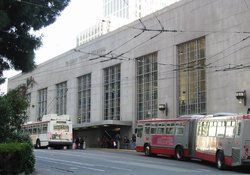 The old Transbay Terminal in 2008. Photo by Binksternet (talk). Sourced from Wikipedia. The old Transbay Terminal in 2008. Photo by Binksternet (talk). Sourced from Wikipedia. One of the largest value capture programs in the United States has been related to the construction of a replacement Transbay Terminal in the heart of San Francisco's financial district. The old terminal (see photo) has been demolished and a new terminal is rising. The new terminal is designed to accommodate bus services (as the prior transit center did), regional rail (as the old center did historically, but not in recent memory), and proposed high-speed rail service from Los Angeles. However, the future of the center depends on a successful value capture program--a program that has been called into question recently by a group of landowners. The stakes are high: a drawn-out lawsuit could delay or even kill the extension of Caltrain from the terminal at Fourth and King streets to the Transbay Transit Center, a $2.6 billion project. Funding for the new terminal is expected to come, in part, from payments made to an assessment district by nearby property owners who are building massive buildings near the terminal. As explained in several September SF Gate articles (article one, two, three), the property owners sought additional development rights on their land holdings and agreed to pay an assessment based on a rate that was decided upon based on the property values at the time and the cost of building the new terminal. In agreeing to the rate, both the public and private sides of the deal agreed to take on the risks of any fluctuation in assessments according to the rate. However, the private-sector developers have complained--even threatening lawsuits--because their property values have gone up since the agreement and, at the agreed upon assessment rate, their payments to the public-sector entities will be significantly higher. The special tax zone, known as a Mello-Roos district, was conceived during the economic boom of 2006 and 2007, but it wasn’t until 2012 that the city proposed a tax rate for the district: 0.55 percent of assessed value, or, at the time $3.33 per square foot. The landowners are squaring off with the City of San Francisco and the dust has not settled on the controversy. However, there is something to be learned from these early stages of the debate. In framing their divergent positions, the public and private sector actors have clearly articulated one of the fundamental choices in transit value capture.
Should the value to be captured in a transit value capture program be commensurate with the cost of services that have created the value (e.g., the capital and operating costs of the proposed transit service can be funded with $30 million per year so $30 million will be captured)? Or, should the captured value be based on the value created by the transit services (e.g., services will be provided that afford landowners the opportunity to build 33% more on their sites and access a much larger labor pool so the transit provider will share in that benefit and be compensated 10% of the total value of the project irrespective of the cost of providing the transit services)? While value capture mechanisms can accommodate either option, clarifying these details well in advance seems to be an important part of avoiding controversy and implementing a successful value capture program.
0 Comments
Leave a Reply. |
AuthorIan Carlton is a transportation and land use expert specializing in transit-oriented development (TOD). He helps clients - including transit agencies, planning departments, and landowners - optimize real estate development around transit. Archives
March 2019
CategoriesSpecial thanks to Burt Gregory at Mithun for permission to use the Portland Streetcar image above.
|
Photo from permanently scatterbrained
 RSS Feed
RSS Feed

